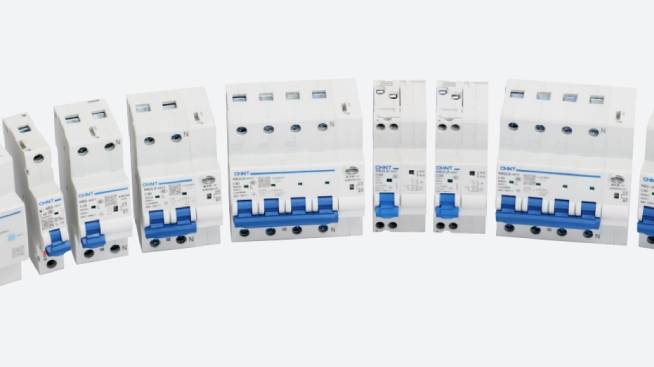Table of Contents |
Regular circuit breakers play a crucial role in electrical systems. They provide important protection against overload, short circuits, and leakage. However, the increasing complexity of modern environments means regular circuit breakers may not meet all emerging demands. Distributed energy resources, more sophisticated controls, and heightened safety standards are increasingly important. Smart circuit breakers are a solution for the needs of today’s world. This article explores the advantages of these intelligent devices and more.
Regular vs. Smart Circuit Breakers: Differences Overview
Regular and smart circuit breakers differ in the protections they provide. Regular circuit breakers offer essential protections like overload protection, short circuit protection, and leakage current protection:
- Overload Protection: This feature safeguards the circuit from excessive currents that can occur when too many devices are connected or a device is faulty.
- Short Circuit Protection: It provides instantaneous protection by quickly cutting off the power when a short circuit is detected, which is an abnormal low-resistance path in the circuit.
- Leakage Protection: Also known as ground fault protection, it prevents electric shock by detecting leakage of current to the ground.
Smart circuit breakers take electrical protection to the next level. They not only provide the basic protections of regular breakers but also offer a range of advanced features that enhance safety, efficiency, and convenience:
- Over/Under-Voltage Protection: Smart breakers can detect voltage levels that are too high or too low and take appropriate action to prevent damage to electrical equipment.
- Over/Under-Frequency Protection: They monitor the frequency of the electrical supply and can interrupt power if the frequency deviates from the set parameters.
- Open-Phase Protection: This feature detects a missing or open phase in the system, which can lead to equipment malfunction or damage.
- Electrical Parameter Measurement: Smart breakers can measure and monitor various electrical parameters such as current, voltage, power, and energy consumption.
- Remote Opening and Closing: With connectivity features, smart breakers can be controlled remotely, allowing for the interruption or restoration of power without physical access to the breaker panel.
The following table highlights the differences between regular and smart circuit breaker protections:
- Open-Phase Protection: This feature detects a missing or open phase in the system, which can lead to equipment malfunction or damage.
- Electrical Parameter Measurement: Smart breakers can measure and monitor various electrical parameters such as current, voltage, power, and energy consumption.
- Remote Opening and Closing: With connectivity features, smart breakers can be controlled remotely, allowing for the interruption or restoration of power without physical access to the breaker panel.
The following table highlights the differences between regular and smart circuit breaker protections:
Protections |
Regular Circuit Breaker |
Smart Circuit Breaker |
Overload protection |
✔ |
✔ |
Short circuit protection |
✔ |
✔ |
Leakage protection |
✔ |
✔ |
Over/under-voltage protection |
✕ |
✔ |
Over/under-frequency protection |
✕ |
✔ |
Open-phase protection |
✕ |
✔ |
Electrical parameter measurement |
✕ |
✔ |
Remote opening/closing |
✕ |
✔ |
Product Highlight: NB2 Series Smart MCB
CHINT is a leading provider of reliable electrical devices. We focus on developing advanced products. These integrate the latest technologies to meet modern electricity needs. Our NB2 Series Smart Miniature Circuit Breaker is one of our most advanced offerings. It provides reliable protection for circuits up to 80A. It is suitable for AC 50Hz power.
Some key features, advantages, and benefits of this advanced intelligent circuit breaker include:
- Remote control functionality for convenient power monitoring and operation
- Electrical parameter monitoring of critical readings like voltage, current, and power usage
- Connectivity with other devices using an RS485 interface or Bluetooth for integrated protection systems
- MCBs comply with the IEC/EN 60898-1 standards while RCBOs meet the IEC/EN 61009-1 standards
- Suitability for both commercial and residential use wherever intelligent circuit control is needed
NB2 Series Smart MCB: Application Scenarios
The NB2 Series is suitable for broad use in residential, commercial, and industrial settings. The key application scenarios of this smart MCB include:
- Supermarket: Provide effective monitoring of current, voltage, and other electric parameters. Enable timely detection of hidden dangers in the circuit. Fault location alarm eliminates the manual reporting process.
- Smart Lamppost: Fault location alarm helps improve maintenance efficiency and reduce traffic hazards caused by lighting problems. Power theft from light poles is sensed through electric energy metering.
- Campus: Provide comprehensive protections. Electricity consumption measurement and analysis for amortization of electricity. Timely find the empty room abnormal power consumption.
- Residential PV/Commercial Building: Allow for remote control and management of electric equipment, energy storage data collection, charging pile power metering, system energy efficiency analysis, etc.
Conclusion
As electricity usage grows increasingly complex, traditional circuit protection may no longer be sufficient on its own. The integrated protections, monitoring functions, and remote control capabilities of a smart circuit breaker address many of the unique challenges of today’s infrastructure and facilities. The NB2 Series from CHINT can reliably protect circuits in diverse applications through automated responses, data insights, and networked accessibility. Visit our website to learn more about our complete lineup of smart electrical solutions.















